Marble has long been admired for its elegance and timeless appeal. From historic estates to modern homes, its soft veining and polished finish bring a refined, luxurious feel to any space. But behind its beauty lies a common concern—slipperiness. While the risk is often overstated, it's still an important consideration for areas like bathrooms, kitchens, and entryways where moisture is more common.
In this guide, we’ll take a closer look at what actually affects marble’s slip resistance, from its natural properties to surface finishes and setting. We’ll also explore how marble look porcelain tiles compare, offering insights that help you choose a safe and stylish flooring option that suits your space.

The Nature of Marble
Marble has long been admired for its distinct veining and refined surface, but its natural makeup plays a big role in how it performs underfoot. To better understand its slipperiness, we’ll look at what marble is made of, how its porosity works, and why not all marble tiles behave the same.
Marble’s Composition and Geological Origins
Marble is a metamorphic rock formed when limestone is subjected to intense heat and pressure deep within the Earth. Its primary component, calcite, gives it that classic polished look, but also contributes to its softness. Other minerals like quartz, mica, or iron oxide may also be present, subtly changing the tile’s density and hardness. These variations in composition affect how smooth or textured the surface feels, which in turn influences how slippery the marble can become.
How Porosity Affects Slip Resistance
Porosity refers to how much liquid a material can absorb, and with marble, this plays a big role in slipperiness. Highly porous marble can absorb more water, which may lead to a slicker surface when wet. Less porous types tend to resist water better, making them a safer option in moisture-prone areas. Understanding a tile's porosity rating can help you choose a finish that’s both beautiful and more practical for your space.
Differences Between Marble Types
Not all marble tiles are created equal; some are denser and smoother, while others have more open veining and softer textures. For example, Carrara marble is often less porous than more decorative varieties, which may reduce slipperiness. Marbles with dramatic veining or color contrast can be more porous and therefore more prone to absorbing water. Knowing which type of marble you're working with helps determine how it will perform in different environments.

Marble Finishes and Slip Resistance
The finish you choose for a marble tile doesn’t just affect its appearance, it directly influences how slippery it might feel underfoot. From high-gloss polished surfaces to more textured or matte options, each finish interacts with moisture and movement differently. Understanding these differences can help you find a style that balances both safety and aesthetics, especially in areas prone to wet conditions.
Polished Marble
Polished marble is known for its mirror-like shine and luxurious, high-end appearance. This effect is achieved through a thorough grinding and buffing process that leaves the surface exceptionally smooth. However, that same smoothness reduces friction, especially when wet, making polished marble one of the most slippery options. It’s best reserved for low-moisture areas or paired with slip-resistant rugs and mats.
Honed Marble
Honed marble offers a matte or satin finish that feels more understated and relaxed compared to polished marble. Its slightly rougher surface adds a bit of grip, making it a safer choice for spaces where moisture is common. While it still requires caution when wet, it offers noticeably better slip resistance. This finish is often chosen for bathrooms, foyers, and other areas where both form and function matter.
Tumbled Marble
Tumbled marble has a worn, textured appearance that gives off a rustic or antique charm. During manufacturing, the tiles are placed in a rotating drum with abrasives, softening the edges and roughening the surface. This process increases traction underfoot, making it one of the safer marble finishes in terms of slip resistance. It’s a popular choice for pool surrounds, patios, and traditional-style interiors where added texture is welcome.
Leather Finish
The leather finish, also called brushed or antique, adds subtle texture and a soft, tactile feel to the marble surface. This look is created by gently brushing the stone with fine abrasives to highlight natural veining and introduce slight surface variation. The result is a finish that retains elegance while offering improved grip compared to polished marble. It’s often used in kitchens and busy living areas where both style and traction are important.

Safety Measures and Prevention
While marble floors bring undeniable elegance, they can be slippery under certain conditions. Thankfully, there are practical ways to reduce this risk without compromising style. From simple additions like rugs to specialized treatments and mindful maintenance, these measures make a big difference in everyday use. Below, we’ll explore easy yet effective steps to keep your marble flooring safe and slip-resistant.
Anti-Slip Mats and Rugs
Strategically placed rugs and anti-slip mats can go a long way in preventing accidents. They add extra grip underfoot, especially in areas prone to moisture like kitchens, bathrooms, and entryways. Look for mats with non-slip backings to ensure they stay securely in place. Beyond safety, these additions can also soften the look of marble and bring warmth to your space.
Non-Slip Coatings and Treatments
For a more permanent solution, non-slip coatings offer added traction without changing the look of your floors too much. These treatments create a subtle texture that helps reduce slipperiness in both dry and wet conditions. Many options are designed specifically for natural stone and can be applied to new or existing marble surfaces. Just be sure to follow product instructions or consult a professional for the best results.
Regular Cleaning and Maintenance
Clean floors don’t just look good, they’re safer too. Dust, spills, and grime can create slick patches, so it’s important to sweep and mop regularly using a marble-safe cleaner. Be sure to dry the floor after cleaning to prevent moisture from lingering. A consistent routine will help preserve the stone’s finish and reduce unexpected slips.
Footwear Choices
Believe it or not, what you wear on your feet can affect safety indoors. Shoes with rubber soles grip better than smooth or hard-bottom styles, especially on polished marble. It also helps to remove wet or muddy shoes before stepping onto marble surfaces. Setting a “shoes-off” policy or offering indoor slippers is a simple way to lower risk, especially in family homes.
Taken together, these small steps can make a big impact. Whether you add a few mats or invest in a quality non-slip treatment, it’s all about tailoring your safety approach to how your space is used. A little planning up front allows you to enjoy your marble floors with peace of mind.

Marble Look Porcelain Tiles as an Alternative
If you love the look of marble but prefer something more practical for everyday use, marble look porcelain tiles are a smart alternative. These tiles are non-porous, highly durable, and well-suited for busy areas where moisture and wear are common. Thanks to modern printing technology, they replicate marble’s elegance with impressive detail, often at a lower cost and with far less maintenance. And with slip-resistant options available, they’re a safe and stylish choice for floors in both dry and wet spaces.
Matte Marble Look Tiles
Matte finishes are a great option if you want the beauty of marble without the extra slip risk. The soft texture diffuses light and provides a better grip underfoot, making it ideal for bathrooms, kitchens, and entryways. It also gives the surface a more natural, understated appearance that feels grounded and warm. This finish strikes a nice balance between elegance and safety.
Polished Marble Look Tiles
If you're aiming for a high-end, luxurious feel, polished marble look tiles bring an undeniable shine and elegance to the room. These tiles reflect light beautifully, enhancing brightness and visual space, especially in small rooms or areas lacking natural light. However, their smooth surface can be more slippery when wet, making them better suited for formal spaces like foyers or decorative dining rooms. They’re all about drama and impact, so use them where you want the floor to steal the show.
Honed Marble Look Tiles
For spaces that need just the right balance between visual softness and everyday functionality, honed finishes strike the perfect middle ground. These tiles feature a muted sheen that feels more relaxed than polished options, while still offering a smoother texture than matte. They're especially well-suited for transitional interiors that blend traditional and modern elements. With a surface that feels warm and grounded, honed tiles are both visually versatile and safer underfoot than glossy alternatives.
Marble Look Tiles in Mosaic Format
Marble look tiles in mosaic format, such as our Aniston 2x2 Matte Porcelain Mosaic Tile in Calacatta Antico above, offer not just design flexibility, but also added safety underfoot thanks to their grout-heavy layout. The smaller tile pieces naturally create more friction, making them a smart option for wet zones like shower floors, laundry rooms, or poolside entries. Plus, their visual texture introduces a layer of detail that adds dimension to any surface, whether as a full floor or decorative accent. If you're after both form and function, mosaics are a thoughtful solution with a lot of character.
Making an Informed Choice for Your Space
Marble floor tiles remain a favorite for their timeless beauty, but their smooth surface can raise concerns about safety, especially in wet or busy areas. By understanding the characteristics that influence slip resistance, such as finish, porosity, and placement, you can confidently determine if marble is right for your space. With the right planning and care, including thoughtful maintenance and smart material choices, marble can be both stylish and safe. It all comes down to how and where it's used.
For those drawn to the marble look but seeking added peace of mind, marble look porcelain tiles present a smart, stylish solution. They bring durability, texture, and aesthetic value, all with fewer maintenance concerns. With our augmented reality (AR) tool, you can preview different tile styles directly in your space before committing. To get started, contact us today to help you find a flooring option that’s beautiful, safe, and suited to your lifestyle.







